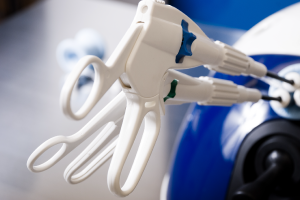Embedded RFID Technology
Case for Use in Life Science and Medical Devices
Article Series, Part 3 of 3
In this three-part article series based on material from our webinar, Embedded RFID for Product Identification, Tracking and Anticounterfeiting, we discuss RFID (Radio Frequency Identification) and the feature rich benefits it provides medical device and industrial equipment manufacturers.
Part 3: RFID Technology for Life Sciences and Medical Devices
Without much argument it is agreed that data based decisions save modern business time, are more likely to lead to increased profits, can improve safety, and enhance user experience. RFID technology is incorporated in life science and medical devices for all of the reasons stated to:
- Improve medical device lifecycle management
- Expand data utilization opportunities for planning, production, and distribution
- Protect intellectual property and safeguard against counterfeit components and devices
- Provide real-time tracking, locating, inventorying, and loss prevention of medical devices
- Automatically identify and capture data into electronic patient records

Data-based decisions improve profitability, safety, and enhance user experience
Using proprietary, patented and patent-pending techniques, Parker can embed a variety of RFID tags into a wide range of medical device component configurations. Parker has been particularly successful in integrating RFID tags within thin walls or space-limited molded polymer components, requiring only very small offsets from the part’s outer surfaces. You can quickly re-engineer existing molded polymer components to include built-in RFID technology and capitalize on the myriad benefits built in data capture technology provides.
U.S. FDA Unique Device Identification (UDI)
By leveraging Parker’s patented technology for embedding RFIDs, you can fast track your UDI compliance for molded polymer medical devices. In addition, you can quickly re-engineer existing molded polymer components to include built-in RFID technology and capitalize on the myriad data capture benefits the technology provides.
Preventable medical errors are estimated to result in close to 100,000 deaths each year due to multiple device-related factors including device malfunctions and product recalls. To ensure that medical device manufacturers address and prevent the recurrence of product issues, the FDA established the Unique Device Identifier (UDI) system to adequately identify medical devices sold in the United States from manufacturing through distribution to patient use. In addition, a machine-readable requirement was added to its UDI Final Rule, requiring device labelers to include a UDI on device labels and packages unless an exception or alternative is provided. If a device is intended for more than one use and reprocessed before each use, the device labeler must also mark the UDI directly on the device. Issued UDIs possess a unique numeric or alphanumeric code consisting of two parts: the device identifier (DI) which is the fixed portion of a UDI, and the production identifier (PI) which identifies characteristics of each unique device.
Benefits for OEMs Beyond UDI Compliance and Automatic Identification and Data Capture (AIDC) for Medical Devices
Compliance enforcement of the UDI Final Rule requirement has been the subject of subsequent guidance statements issued by the FDA to its staff. However, using embedded (molded-in) RFID tags provides numerous opportunities for product enhancement and/or differentiation, including high-level anti-counterfeiting characteristics, damage/tamper resistance and automatic parameter settings.
There are many benefits to using Parker’s molded-in RFID tags. They have no labels, adhesives or plugs to fail; are encapsulated in (and protected by) the device’s material; and are tamper and counterfeit resistant. In addition, Parker’s embedded RFID tags:
- Are covert in opaque materials.
- Match the device’s resistance to autoclave and gamma sterilization cycles.
- Have no contaminant-harboring seams or manufacturing marks.
- Allow equipment to automatically recognize components with embedded tags.
- Provide onboard tracking of device life cycles.
- Are available now for embedding into classes I, II and III devices.
For additional details on Parker capabilities in building RFID compliance directly into your medical plastics, please contact Parker's Composite Sealing Systems Division.

Related information:
Learn more about Parker EMG Life Sciences Sealing Solutions

©2022 Parker Hannifin Corporation
